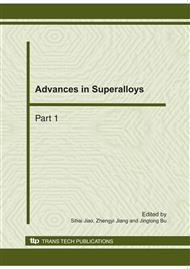p.615
p.619
p.623
p.631
p.635
p.641
p.646
p.650
p.654
Formation of Precipitations in Ultra-Low Carbon Microalloyed Steels Treated by Rapid Tempering
Abstract:
The aim of the determination is to study formation of precipitations by rapid tempering using thermal simulation tester and effects of precipitations on lower-temperature toughness property. A ultra low carbon microalloyed quenched steel containing alloying elements, such as 0.06wt%C-0.04wt%Nb-0.06wt%V-0.008wt%Ti, is tempered at 620°C for holding time 70min in conventional resistance furnace , and tempered rapidly at 620°C for 40s、80s and 120s, respectively. Both microstructures and impact properties were also investigated. It was observed that the nanoscale cementite particles were obtained by rapid tempering for 40s. Furthemore, the Charpy impcat energy of these specimens holding time 40s is higher than that of others. In comparison with conventionally processed, rapid tempering for low carbon alloyed steel can achieve good toughness due to the nanoscale cementite particles and offer the potential advantage for significant time and cost savings.
Info:
Periodical:
Pages:
635-640
Citation:
Online since:
October 2010
Authors:
Price:
Сopyright:
© 2011 Trans Tech Publications Ltd. All Rights Reserved
Share:
Citation:


